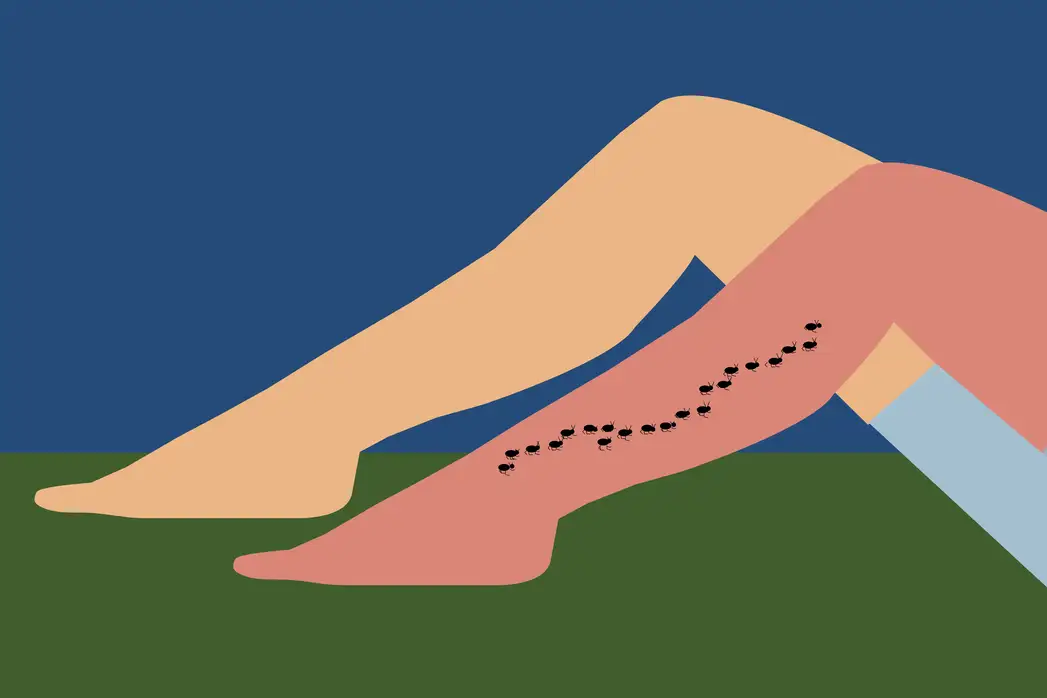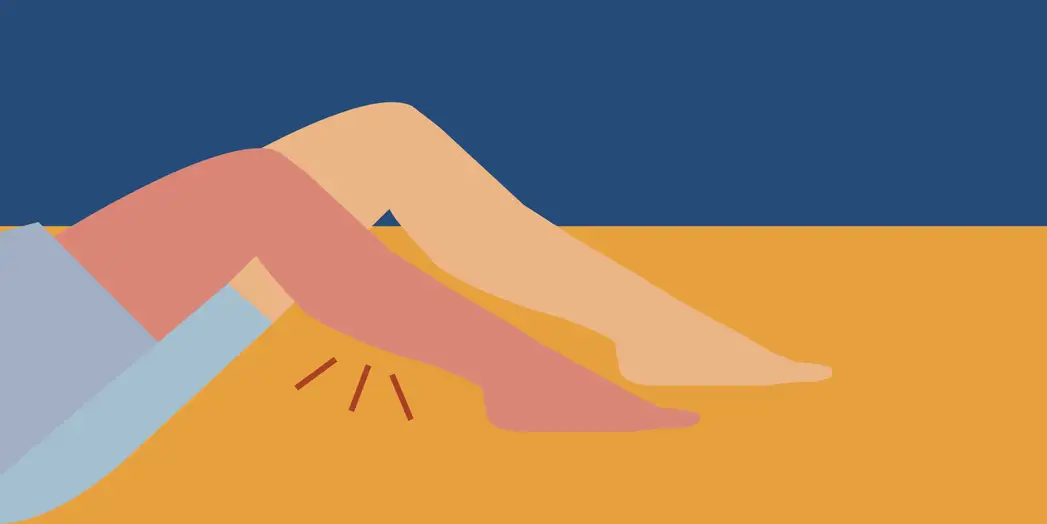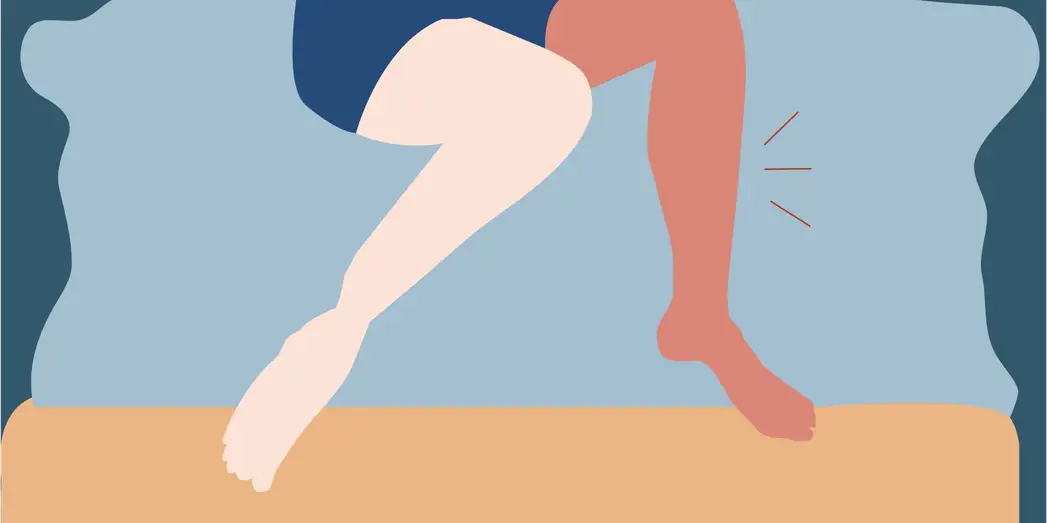Parasomnias are a category of sleep disorders that involve abnormal movements, behaviours, emotions, perceptions, and dreams during sleep.
It’s common knowledge that well known parasomnias, such as sleepwalking, often involve movement during sleep. But there are a number of other conditions directly related to movement that are associated with disturbed sleep.
In this article we’ll examine these common sleep disruptors:
- restless legs syndrome (RLS)
- nocturnal leg cramps
- periodic limb movement disorder (PLMD).
You may have experienced one or all of the above and find yourself struggling to enjoy a good night’s sleep. If so, you’re not alone and we’re here to help.

Restless legs syndrome
Restless legs syndrome is a type of sleep-related movement disorder — although it only occurs when you’re awake! You’ll experience an irresistible urge to move your legs and often struggle to enjoy a good night’s rest. If you experience RLS then you may feel:
- sensations of pain
- tingling
- itching
- prickling.
People with RLS have described it as feeling like ‘ants crawling under the skin’ or ‘as though my legs are full of fizzy water’. In most cases these sensations are only relieved by moving your legs. However, the sensations invariably return when your legs are still again.
RLS can occur if you’re immobile in a chair for any length of time but it’s most likely to occur when you lie down in bed. Achieving quality sleep can become extremely difficult for people who experience restless legs syndrome.
Summary: restless legs syndrome
- In one study, 7.2% of respondents reported symptoms of RLS, with 5% of people experiencing symptoms at least weekly and 2.7% more frequently. 1
- Some pregnant women develop the condition, especially in the last trimester of pregnancy. 2
- RLS can be caused by iron deficiency, anaemia or folic acid deficiency. 3
- The symptoms of RLS may also be due to another underlying medical condition such as: diabetes, rheumatoid arthritis, neurological diseases or Parkinson’s disease.
- Certain drugs can make RLS worse. These include: antidepressants, calcium blockers, anti-nausea medications, some anti-allergy medicines and too much caffeine.
- RLS may be helped by ensuring your diet contains adequate amounts of iron, folic acid and minerals such as calcium, potassium and magnesium.
- Walking, stretching and yoga may also help to relieve the symptoms.4
It’s important to see your GP if you feel you may be experiencing symptoms of restless legs syndrome.
Treating restless legs syndrome
There are a number of medicines, available from your GP, that are licensed in the UK for the treatment of RLS. These include:
These same drugs, under the brand names Requip, Mirapex and Neupro respectively, are also licensed by the FDA in America for the treatment of RLS.
Can you control restless legs syndrome?
Using licensed medication can make a difference. The drugs outlined above are known as dopamine agonists — they’re able to increase levels of dopamine.
Dopamine has many important functions in the brain but when it comes to RLS it can play a key role in movement control.
When your dopamine levels fall this can lead to muscle spasms and involuntary movements.
Dopamine levels naturally reduce as the day progresses and this may account for the fact that the symptoms of restless legs syndrome are commonly worse in the evening and during the night.

Leg cramps at night
Leg cramps are a common — and often excruciatingly painful — problem at night. Studies suggest that most older adults have experienced nocturnal leg cramps at least once.
Leg cramps occur as sudden and intensely painful, involuntary contractions of the lower limbs. These cramps usually affect the calf muscle although you may experience pain in your thighs or feet.
During a calf cramp, the muscles involved are firm and tender and the feet and toes are bent at the ankle away from the body.
Cramps may last anywhere from a few seconds to several minutes before remitting spontaneously.
Summary: nocturnal leg cramps
- Men and women are equally likely to experience nocturnal leg cramps.
- The occurrence of cramps has been found to increase with age.
- Most nocturnal leg cramps appear to be idiopathic — there is no known cause for them.
- Various neurologic, endocrine, metabolic or vascular conditions may lead to nocturnal leg cramps.
- Several medications are associated with the occurrence of leg cramps. These include medicines for: high blood pressure, osteoporosis, asthma and statins for cholesterol.
- Pregnancy has been linked to leg cramps with 33-50% of women affected. Leg cramps tend to get worse as the pregnancy progresses.
- In most people (73%), the cramps occur exclusively at night.
- In 40% of people, cramps occur more than three times a week and in 6% of people, leg cramps may occur daily. 5 6

How to treat leg cramps
Although probably harmless — and possibly worthwhile for some — there is little evidence that non-pharmacological methods of preventing leg cramps actually work.
Eating certain foods or supplementing your diet with various minerals are popular options but there’s no proof that these approaches work for most people.
Physical therapies — such as walking, stretching and massage — are recommended as first-line treatments.
If you’re looking for an alternative then there is a licensed over-the-counter medication for the prevention of leg cramps available.

Periodic limb movement disorder
Periodic limb movement disorder (PLMD) is a sleep disorder which prompts you to make kicking or jerking movements with your legs (and less frequently with your arms) during sleep.
Although unrelated to RLS, the two conditions are often confused with each other. RLS only occurs when you’re awake whereas PLMD only happens when you’re asleep.
You’re usually unaware of these involuntary movements and it’s often down to the person you’re sharing your bed with to alert you to the problem… and endure the odd bump in the night!
If your partner repeatedly jerks their limbs during the night or appears to ‘punch’ or ‘kick’ you then you should suspect PLMD.

Summary: periodic limb movement disorder
- There’s some debate as to whether the repeated movements do, in fact, disturb the sufferer’s sleep and cause drowsiness during the day.
- PLMD may be a contributory factor in certain cases of insomnia.
- Women are more likely to experience the disorder than men.
- Causes include too much caffeine, stress and mental health problems.
- A study revealed that 5.9% of the population said they experienced PLMD at least two or three nights per month.
- 5% reported having it at least one night per week and 7.8% said it occurred at least two nights or more each week.
- The overall prevalence was comparable across all age groups. 7 8
How to treat periodic limb movement disorder
There are no medicines explicitly licensed in the UK for the treatment of PLMD, although medications used in the treatment of RLS have been successfully used to control PLMD.
Summary
- Restless legs, leg cramps and limb movement during sleep are relatively common.
- Restless legs syndrome occurs when you’re awake.
- Nocturnal leg cramps are sudden and painful.
- Periodic limb movement disorder occurs when you’re asleep.
- Medication is available to treat restless legs syndrome and leg cramps.
- Medication for RLS can help to control PLMD.
- If you’re experiencing any of the symptoms described in this article, consult your doctor.
References
- Allen RP, Walters AS, Montplaisir J, Hening W, Myers A, Bell TJ, et al. Restless legs syndrome prevalence and impact: REST general population study: REST general population study. Arch Intern Med. 2005;165(11):1286–92. ↩︎
- Srivanitchapoom P, Pandey S, Hallett M. Restless legs syndrome and pregnancy: A review. Parkinsonism Relat Disord. 2014;20(7):716–22. ↩︎
- Bayard M, Avonda T, Wadzinski J. Restless legs syndrome. Am Fam Physician. 2008;78(2):235–40. ↩︎
- Hallegraeff JM, van der Schans CP, de Ruiter R, de Greef MHG. Stretching before sleep reduces the frequency and severity of nocturnal leg cramps in older adults: a randomised trial. J Physiother. 2012;58(1):17–22. ↩︎
- Allen RE, Kirby KA. Nocturnal leg cramps. Am Fam Physician. 2012;86(4):350–5. ↩︎
- Ohayon MM, Roth T. Prevalence of restless legs syndrome and periodic limb movement disorder in the general population. J Psychosom Res. 2002;53(1):547–54. ↩︎
- Hornyak M, Feige B, Riemann D, Voderholzer U. Periodic leg movements in sleep and periodic limb movement disorder: prevalence, clinical significance and treatment. Sleep Med Rev. 2006;10(3):169–77. ↩︎
- Aurora RN, Kristo DA, Bista SR, Rowley JA, Zak RS, Casey KR, et al. The treatment of restless legs syndrome and periodic limb movement disorder in adults—an update for 2012: practice parameters with an evidence-based systematic review and meta-analyses: an American Academy of Sleep Medicine Clinical Practice Guideline. Sleep. 2012;35(8):1039–1062. ↩︎